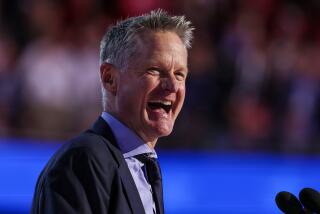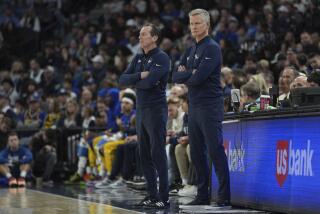Healing Process Is Mental for Kerr, Too : He’s Haunted by Knee Injury Suffered in World Basketball Championships
Sometime this weekend, Arizona basketball player Steve Kerr will return to his home in Pacific Palisades and try to dream some happier dreams.
Now, lying in a hospital bed in Tucson, he is haunted by a nightmare, and the time of day has nothing to do with it. His are traumatic thoughts, even at high noon in the Arizona desert.
“I dream about it a lot, about that specific play,” Kerr said Thursday. “I sleep a lot during the day, and I think you sleep pretty lightly then. I’ll just kind of be dozing off and I envision myself jogging down court all by myself, and suddenly the leg gives out.
“The natural reflex is to jerk the leg real fast, except that I’m in bed and it really hurts when I do that. I’ve been doing that a lot.”
A week ago, Kerr’s emotions were a little different. Although he was an All-Pacific 10 selection, known primarily as a play-making guard, Kerr was hardly expected to determine any games for the United States during the world tournament in Madrid, Spain. His Arizona teammate, Sean Elliott, still two months shy of his sophomore year, was afforded more attention.
In this somewhat familiar role--he wasn’t even recruited out of Palisades High School by UCLA, although his parents taught at the school and he was a Bruin ballboy--Kerr came through again.
After scoring 11 points in a 74-70 loss to Argentina, the Americans’ only defeat of the tournament, Kerr came off the bench July 14 and made 4 of 7 three-point shots, finishing with 15 points as the United States beat Canada, 77-65.
“These are things we (at Arizona) knew he could do when he went over there,” Wildcat assistant coach Randy Brown said. “Bobby Cremins (coach at Georgia Tech and an assistant in Spain) said it best during the games: ‘Not a lot of people know about Steve, but I guarantee a lot of people would like to have him.’ ”
But three nights later, even though he scored 14 points in a 96-80 victory over Brazil in the semifinals, his nightmares began.
He brought the ball downcourt, just as in the dream, drove the lane and pulled up. He wasn’t quite sure whether he wanted to shoot or pass.
“I think my body weight was shifted toward making the pass, but then I changed my mind at the last second and looked for the shot,” Kerr said. “I didn’t have time to shift my weight. When I came down, the foot didn’t move, but the knee did. Everything just kind of blew out.”
Just as in the dream.
End of tournament. End of senior season, months before it even was to start. End of career?
Tim Taft, the American team physician in Spain, initially said that the tears in the front and outside ligaments of the right knee were so bad that Kerr might never play again. But George F. (Kim) Hewson Jr., the orthopedic surgeon who performed the operation Monday at St. Mary’s Hospital in Tucson, had more calming news at a press conference. “I think there’s every chance for Steve to return to basketball,” he said.
Indeed, the plan is for light rehabilitation in Southern California until late August, when Kerr will return to Tucson for school. He will sit out next season altogether but hopes to begin running sometime in February and to begin playing basketball two months after that.
Last Sunday, from half a world away, Kerr watched the United States defeat the Soviet Union for the gold medal, 87-85. He said he handled it well up until the end.
“But as soon as the game ended and the buzzer sounded and I saw them all celebrating, it was really tough to watch,” he said.
Kerr got his gold medal--and the game ball--a couple of days later when Elliott and Lute Olson, head basketball coach at Arizona and the American team in Spain, called reporters to the hospital room for an impromptu bedside celebration. Was that on Tuesday? Yeah, Tuesday . . . he’s pretty sure.
“I was on morphine at the time, so I think I was out of it,” he said. “But it was a nice little ceremony. It’s not like I’m too busy to let people in. I’m absolutely bored.”
Olson has several options for replacing Kerr this coming season. He could go with a sophomore--Kenny Lofton--or move over a shooting guard--Eric Cooper from Los Angeles Banning High, or Bruce Fraser from Long Beach Wilson and Long Beach City College.
Even incoming freshman Harvey Mason from Crescenta Valley High in La Crescenta, though known as a long-range shooter, will be given a chance for the spot. And Olson has said that, in dire situations, Elliott--the 6-7 the Pac-10 co-freshman of the year in 1986--and 6-6 Craig McMillan could play the point.
Kerr, in the meantime, will be looking forward to the 1987-88 season.
More to Read
Go beyond the scoreboard
Get the latest on L.A.'s teams in the daily Sports Report newsletter.
You may occasionally receive promotional content from the Los Angeles Times.










